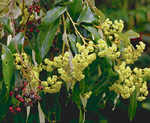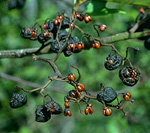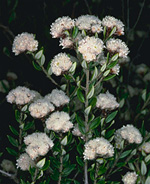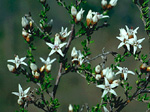 |
This large and widely distributed family is found in much of Australia except the plains and sandy deserts of Central Australia. There are several centres of diversity, one in the rainforests of north-east Queensland, one in south-west Western Australia in forests and shrublands, and one in similar habitats in south-eastern Australia.
Characteristic features of the family Rhamnaceae in Australia include: - shrubs or trees, rarely climbers, with simple, usually alternate leaves, many with stellate hairs on leaves or branchlets
- flowers small but often aggregated into showy panicles or heads, usually with 4-5 small, white, greenish, cream or yellow, rarely pink, free petals and sepals, or the petals fused into a tube (Cryptandra), rarely absent
- stamens the same number as and adjacent to, and often hooded or cupped by, the petals
- ovary inferior to superior, developing into a small capsule, berry or drupe, sometimes winged
Description
Evergreen or semi-deciduous trees, or shrubs, or woody or
herbaceous vines climbing by scrambling, axillary tendrils or hooks. Leaves
sometimes ±absent. Stems unarmed, or rarely with thorns or spines
arising from the leaf axils. Plants glabrous or with simple, dendritic
or stellate, non-glandular, unicellular, uniseriate or multiseriate hairs.
Leaves well developed, or rarely much reduced (i.e. to scales, etc), or
entirely absent, alternate and spiral, rarely distichous, opposite, or
apparently whorled, petiolate or subsessile. Stipules apparently absent,
or present and distinct and free from the petiole, encircling the petiole
base, or intrapetiolar, scale-like, or membranous, or spine-like, falling
off early or persistent. Lamina simple, symmetric or rarely conspicuously
asymmetric, pinnatifid, rarely pinnatisect, filiform, acicular, subulate,
linear, lanceolate, ovate, elliptic, oblanceolate, oblong, flabellate
or orbicular; base cuneate, attenuate, rounded, cordate or oblique; margins
entire, crenate, dentate or serrate, ±flat, revolute or recurved;
one-veined, or the venation pinnate or parallel, with the midrib conspicuous,
and the tertiary venation reticulate or not; surfaces not punctate; herbaceous.
Domatia present. Usually with all the flowers bisexual, or rarely with
male and female flowers occurring on the same plant. Inflorescences terminal
or axillary, consisting of capitula, racemes, panicles, dichasial or monochasial
cymes or solitary flowers. Bracts present. Pollination by insects or birds.
Flowers odourless, fragrant or malodorous, sessile or stalked. Floral
disc rarely present; nectaries present on the disc. Free hypanthium ±present
or apparently absent. Perianth regular, of 2 dissimilar whorls or of 1
whorl only, rarely whorls ±similar. Calyx segments free, with (4–)
5 sepals, valvate in bud, herbaceous. Corolla segments free, with 0 or
(4–) 5 petals, alternating with the sepals, valvate or open in bud, white,
cream, yellow or green, rarely pink, without contrasting markings, membranous;
claws present or absent; lobes ±entire or notched, emarginate,
bifid or bilobed. Fertile stamens (4–) 5, alternating with the sepals,
free or at least partly fused to the corolla, free of the ovary and style,
distinct from each other, all ±equal. Anthers dorsifixed or basifixed,
versatile or not versatile, opening sideways by longitudinal slits, 2-celled;
appendages absent or rarely basal. Ovary superior and sessile, or part-inferior,
or inferior. Carpels (1–) 3–5, fused; ovary with (1–) 2–4 locules. Style
terminal, single and unbranched, or branched above, or branching from
the base. Ovules 1–locule, stalked or sessile; placentation basal.
Fruit a dry dehiscent capsule, irregularly dehiscent, septicidal or loculicidal,
rarely with explosive dehiscence, or an indehiscent samara, or a fleshy
indehiscent berry, or a drupe; the perianth on the maturing fruit deciduous,
or dry and persistent. Disseminule macro-surface featureless, or winged;
micro-surface ±smooth, cream, orange, red, green, brown, grey or
black, without contrasting markings, or conspicuously patterned, glossy
or dull. Seeds (1–) 3 (–4) per fruit. Aril present or absent. Cotyledons
2. Embryo straight.
(Note: this description has been generated from the coded data compiled
for the key. Any errors in the key data will be reflected in the descriptions.)
A treatment of the family Rhamnaceae has not yet been published in the Flora of Australia. It will appear in Volume 24.
Australian genera of Rhamnaceae (as recognised for the Flora of Australia)
† = some species native, others introduced
* = all species introduced
Alphitonia
Blackallia
Colubrina
Cryptandra
Discaria
Emmenosperma
Gouania
*Hovenia
*Noltea
Pomaderris
Rhamnella
†Rhamnus
Sageretia
Schistocarpaea
Siegfriedia
Spyridium
Stenanthemum
Trymalium
Ventilago
†Ziziphus

|
  |

Alphitonia excelsa (flowers and fruits)
Photo: G.Leiper © G.Leiper

Alphitonia petriei (fruits)
Photo: H.Nicholson © H. & N. Nicholson

Cryptandra (Spyridium) scortechinii (flowers)
Photo: M.Fagg © ANBG

Cryptandra sp. (flowers)
Photo: G.Leiper © G.Leiper

|
 |
|